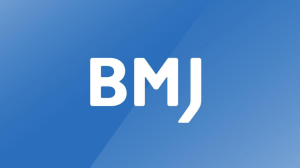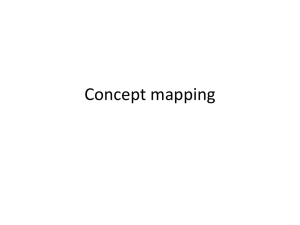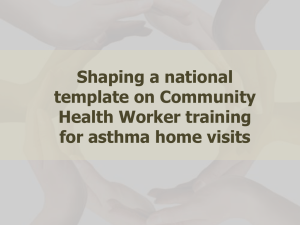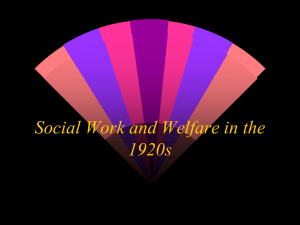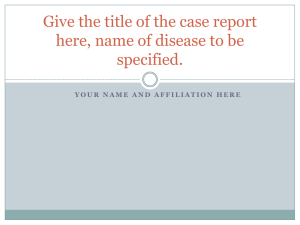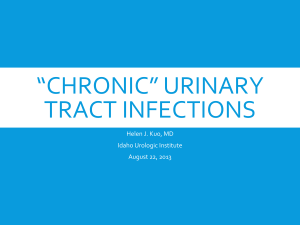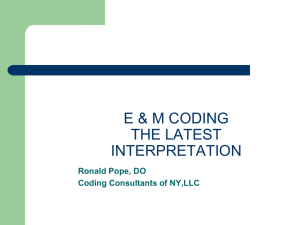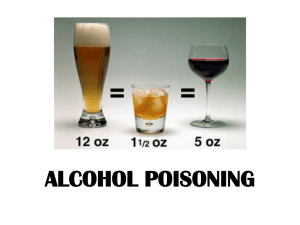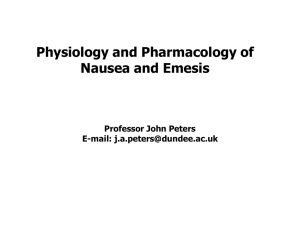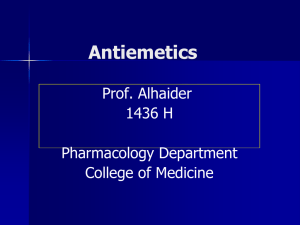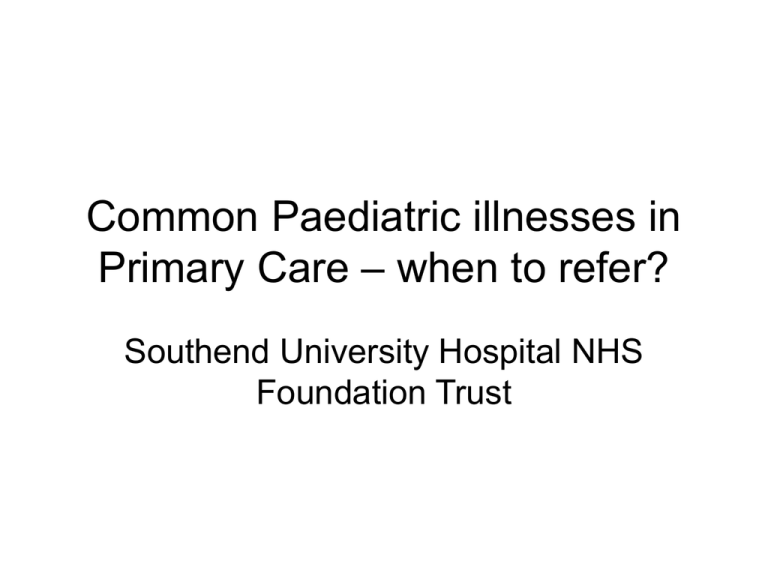
Common Paediatric illnesses in
Primary Care – when to refer?
Southend University Hospital NHS
Foundation Trust
Paediatric referrals
• Increased by 38% over the previous year
• Total Outpatient referrals per year: 15,480
– Choose and Book
– New referrals
– Rapid access
– follow ups
750
3,850
2400
8440
• Inpatient admissions:
1300
– Length of stay
1.1 days
Urgent Referrals
• The acutely unwell infant
• Uncertain diagnosis and you are worried!
• Extreme parental anxiety
• Worries about child safety or non-accidental injury; also
contact social services
• Low threshold for admission in:
– Children with co-morbidity eg diabetes, cystic fibrosis, on
immuno-suppressives/steroids
– Past history of intensive care treatment eg diabetic ketoacidosis,
life-threatening asthma
– Young infants below 3 months
Recognition of the sick infant
Important considerations
• Completely undress the infant (remember it is easy to
miss petechiae or bruising or a hernia)
• Infants are difficult to assess objectively
• Illness can result in rapid deterioration over a few hours.
It is therefore helpful to re-assess the child after a
suitable interval
• Younger the baby lower the threshold of admission
• With exception of dehydration, an infant that is feeding
well is unlikely to have a serious illness
Recognition of the Sick Infant
significant symptoms
•
•
•
•
•
•
•
•
•
•
Reduced feeding (<50% of normal in previous 24 hours)
Persistent vomiting (>50% of the previous 3 feeds)
Any bile-stained vomiting
Frank blood in stools
Less than 4 wet nappies in 24 hours
Rapid breathing – particularly if noisy and of sudden
onset
Inappropriate drowsiness or irritability
Convulsions
Persistently unusual cry
History suggestive of apnoeic episodes
Recognition of the Sick Infant
significant signs
• Activity:
– Floppy
– Reduced response to verbal or painful stimuli
• Dehydration:
–
–
–
–
tachycardia >120/min
reduced skin turgor of ≥2secs
Reduced capillary refill ≥3secs
dry mouth, sunken fontanelle
• Respiration:
– Tachypnoea: ≤5years: >50/min; >5years: >30/min
– Grunting and rib recession
• Others:
–
–
–
–
Marked pallor / Non-blanching rash
Bulging fontanelle, neck stiffness
Limping / joint swelling
Febrile: <3months ≥380C
≥3months ≥390C
Feverish illness in children under 5 years
Green
Low risk
Amber (REFER)
Intermediate risk
Red (REFER)
High risk
Normal
Pale-reported by
parent/carer
Pale/mottled/ashen
Responds
normally to
social cues
stays wake or
awakens quickly
strong normal
cry/not crying
Not responds normally
No response
Appears ill
Unable to rouse or if
roused does not awake
Weak/highpitched/continuous cry
Respiratory
Normal
Nasal flaring
respiratory rate (RR):
>50/min (6-12months)
>40/min (>12months)
Grunting
RR >60/min
Chest wall recession
Hydration
Normal skin,
eyes and moist
mucus
membranes
Dry mucus membrane,
poor feeding (<50% intake
of normal), capillary refill
time(CRT)≥3secs
Decreased skin turgor
fever≥5days, limping/joint
swelling, new lump >2cm
<3months ≥380C
≥3months ≥390C
Non-blanching rash,
bulging fontanelle, neck
stiffness, convulsions,
bilious vomiting
Activity
Other
Decreased activity
No smile
Common Outpatient Referrals
•
•
•
•
•
•
•
•
•
•
Eczema
Food allergies
Chronic asthma
Chronic cough
Heart murmur
Vomiting
Diarrhoea
Chronic abdominal pain
Urinary Tract Infection
Enuresis
• Constipation and soiling
• Obesity and excessive
weight gain
• Headache
• Musculoskeletal problems
• Behavioural disorders
• Common surgical
conditions
• Development concerns
• Non-accidental injury
• Crying baby
Eczema
• Diagnosis: Itchy skin + 3 or
more of following:
–
–
–
–
Onset <2years
History of asthma/rhinitis
Dry skin in past 12 months
Flexural dermatitis
• Treatment:
– Emollients and moisturisers
– Hydrocortisone1% TDS on
inflamed skin even on face.
– Stronger steroids (eumovate,
dermovate, betnovate) used
only for short term (1-2
weeks), avoid in children<2
years and avoid face.
– Antibiotics
• Leaflet from eczema society
When to Refer:
(dermatologist/paediatrician)
– Uncertain diagnosis
– Treatment ineffective
– Non-responsive eczema on
the face
– If child is experiencing
sleep disturbance, poor
school attendance or
significant social or
psychological problems
– If eczema associated with
severe and recurrent
infections
Food allergies
• Most children with milk allergy
grow out of it by 3 years
• Most children with egg allergy
grow out of it by 5 years
• Most children with peanut
allergy remain allergic (1 in 5
may resolve)
• Common food allergens: milk,
egg, soya, wheat, seeds, nuts
(peanuts and treenuts), fish,
shellfish, exotic fruits eg kiwis,
avocadoes
• Symptoms of tingling tongue,
urticarial rash, angioedema (lip
or facial swelling), vomiting,
diarrhoea (mild allergic
reaction)
• Respiratory symptoms or
cardiovascular collapse
(shock) means Anaphylaxis
(severe allergic reaction)
When to refer:
• Severe allergic reaction-anaphylaxis
• History of poorly controlled asthma
• Multiple food allergies
• Unidentified triggers
• High parental anxiety
• Frequent reactions
Tests:
– History is often clear and no
diagnostic tests are needed
– Skin prick tests and RAST can
be misleading, particularly in
young children or those with
eczema
– Generally a negative result is
highly reliable, but there are often
false positives
– Tests cannot reliably identify the
severity of the allergy
– Oral challenges are the only way
to be sure a child has outgrown
an allergy, but must be
conducted in hospital if there is
any risk of a severe reactioin
Chronic Asthma-When to Refer:
•
Poor response to 800µg/day beclomethasone (or equivalent) – step 4 of
BTS/SIGN guidelines and should be on other asthma treatments; concordance
and drug delivery need careful assessment
•
Poor response to 400 µg/day beclomethasone (or equivalent) and needs addon treatments that GP is unfamiliar with
•
Young child (<5years); uncertainty about drug delivery. Needs careful
assessment of inhaler techniques and expertise of specialist asthma nurse
•
Young child (<1year); often doubt about diagnosis
•
Features that point to another diagnosis eg finger clubbing, focal signs in
chest, failure to thrive, symptoms present from birth
•
Recurrent admission to hospital; suggests dangerous pattern of asthma
•
Frequent (>1/month) use of courses of oral prednisolone
•
Particularly severe acute asthma, such as needing intravenous treatments or
intensive care. These are high risk patients
Chronic cough
Defined as daily cough lasting
≥4weeks
• Associated Wheeze,
exacerbation with viral illness,
exercise or during sleep,
personal or family history of
atopy – possible asthma
• Barking or brassy cough –
croup, tracheomalacia, habit
cough
• Paroxysmal (with/without
wheeze) – pertussis and
parapertussis
• Check immunisation status,
exposure to tobacco smoke
and evidence of personal or
family history of allergies
When to Refer:
• Neonatal onset of cough
• Chronic moist/purulent cough
• Cough started and persists after
choking episode
• Cough occurs during or after
feeding
• failure to thrive
• Finger clubbing
• Contact with TB
• Associated abnormalities
(cardiac, neurodisability, immune
deficiency)
Heart murmur
• Central cyanosis (blue
extremities and mucus
membranes ie tongue) is a
feature of cyanotic congenital
heart disease. Cyanosis
restricted to extremities
(peripheral cyanosis) is normal
in infancy in the absence of
other symptoms or signs.
• Feel for apex of heart
(dextrocardia)
• Feel femoral and brachial
pulses (coarctation of aorta)
• Innocent heart murmur is
never associated with
symptoms.
• Innocent heart murmurs are
soft, varies with posture /
respiration, ejection systolic,
high-pitched, grade1-2/6 and
localised to praecordium; no
praecordial thrill
When to refer:
– Associated with symptoms
of central cyanosis, pale,
prolonged feeding (>30
mins), short of breath or
failure to thrive.
– Infants below 1 year
– Doubts about the murmurwhether pathological
– Parental anxiety
– History of congenital heart
disease in siblings or
parents
Vomiting infant
Differential Diagnosis:
– Viral infections (URTI /
gastroenteritis)
– Gastroesophageal reflux
(GOR) (worse with feeds and
when lying flat; often good
response to feed thickeners
eg infant Gaviscon)
– Pyloric stenosis (1-4 months
age, weight loss)
– Cow’s milk protein intolerance
(often history of associated
diarrhoea, atopic tendency
and failure to thrive)
– Surgical causes eg
intussusception, malrotation
(bilious vomiting)
– Raised intracranial pressure
(lethargy, bulging fontanelle,
separated sutures)
When to refer:
– Bilious vomiting
– Weight loss or Failure to thrive
– Unable to maintain hydration
– Complicated GOR associated
with symptoms ie failure to
thrive or crying/irritability or
aspiration/apnoeic episode
– Raised intracranial pressure
(lethargy, bulging fontanelle,
separated sutures)
Diarrhoea
• Differential diagnosis:
– Viral / bacterial gastroenteritris
– Non-enteral infections such as
UTI, meningitis or pneumonia
– Cow’s milk protein intolerance
or secondary lactose
intolerance
– Toddler’s diarrhoea / IBS
– Malabsorption: cystic fibrosis,
coeliac disease
– Inflammatory bowel disease
– Surgical causes: appendicitis,
intussusception
– Constipation with overflow
When to refer:
– Blood in the stools
• ≥5 stools/day in a well
child
• Persists beyond 7 days in
a well child
• Unwell child
– Lethargy / persistent crying or
irritability / poor feeding
– Acute episode of diarrhoea
lasting for >2 weeks
– Failure to thrive
– Failed oral rehydration
because of persistent vomiting
or increasing dehydration
– Parental anxiety / social
concerns
Chronic abdominal pain
• Diagnosis:
– Intermittent abdominal pain on
at least 3 occasions over a 3
month period
– Pain interferes with normal
activities
• Common causes:
–
–
–
–
–
Functional abdominal pain
IBS
Abdominal migraine
Constipation
Mesenteric adenitis
• First line investigations
suggested:
– Urine C&S, Stool C&S, FBC,
U&Es, LFT, CRP, ESR,
Coeliac screen
When to refer:
– Significant illness behaviour,
especially time off school
– Weight loss / failure to thrive
– Bilious vomiting
– Bleeding PR
– Frequent nocturnal pains
– Abnormal examination
– Abnormal first line
investigations
The crying baby
A normal baby’s cry increases from birth to a maximum at 2 months averaging
2-2.5 hours a day, with a peak between 6-12pm. Tense anxious parents
have tense, anxious babies! Commonest are hunger, dirty nappy, need for
company or tiredness
Refer if:
–
–
–
–
–
–
–
Baby appears systemically unwell
Baby is febrile without a clinical focus
Baby has bilious vomiting
Baby cries, with episodes of pallor
Baby has hernia or swollen testes
Baby is of socially isolated carers
Baby appears to have limb pain or there are concerns about child abuse
Urinary Tract Infection
•
Diagnosis:
– Upper UTI (acute
pyelonephritis):
fever/loin pain or tenderness
+ bacteriuria
– Lower UTI (cystitis):
dysuria +bacteriuria
•
Investigation:
– For <3yrs: Clean-catch/bag
urine for C&S
– For ≥3yrs: Urine dipstick
leucocytes / Nitrites:
• + /+ = UTI - treat
• - / + = treat as UTI
• + / - =treat if symptoms
• - / - =No UTI
•
Treatment of Lower UTI:
Trimethoprim or amoxycillin or
cephalosporin for 3 days
Always ask for Renal tract ultrasound
scan (USS) before referral
When to refer:
– <6months
– Upper UTI
– Atypical UTI which includes:
• Failure to respond to
treatment with suitable
antibiotics within 48 hours
• Seriously ill
• Poor urine flow
• Abdominal or bladder
mass
• Infection with non-E coli
organisms
– Recurrent UTI
– Abnormal renal tract USS in
<6months age (pre-existing
renal tract abnormalities)
Enuresis
• Diagnosis:
– Bedwetting over 6 years of
age without neurological or
urological cause
– Make sure there is no UTI
• Treatment:
– Not indicated under 6 years
other than star chart to
encourage / reward
progress
– Refer to Incontinence
Nurse Specialist
– Desmomelt (use for shortterm ie holidays or initial 3month trial)
When to refer:
– Children with daytime
urinary problems
– Treatment failures
– Concerns over family
dynamics (parents need to
understand this is a
developmental problem,
not bad behaviour)
Constipation and Soiling
• Diagnosis: Either / or
– infrequent (≤1/week) stools
– firm/hard consistency stools
– difficult/painful defaecation
• Treatment:
– Diet (high roughage)
– Develop habit of sitting on
toilet with good foot rest 20
mins after meals
– Laxatives (senna liquid+/lactulose; Movicol paediatric
sachets). Sometimes higher
than recommended dose is
necessary. Laxatives are safe
– If perianal area inflamed –
consider antibiotics
When to refer:
– Passage of toothpaste-like
stools (?anal stenosis)
– Neonatal onset of
symptoms
– Cerebral palsy, spinal
abnormalities,
developmental delay
Obesity and Excessive weight gain
• Diagnosis:
– BMI >98th centile = Obesity
– BMI >91st centile =
overweight
– Weight crosses centiles
upwards, and exceeds
height centile by at least 2
centiles
• Treatment:
– Weight maintenance is an
acceptable goal
– Family centred approach
– Healthier diet
– Increase in habitual activity
to a minimum of 30
mins/day
– Reduction in sedentary
behaviour (eg
TV/computers) to
<2hrs/day or <14hrs/week
When to refer:
– <2years, >99.6th
centile for BMI
– Exhibiting obesityrelated morbidity ie
sleep apnoea,
hypertension/hyperlipi
daemia, diabetes,
orthopaedic disorders
or psychological
problems
– Associated physical or
learning difficulties
Headache
• Diagnosis:
– Migraine/migrainous
features: paroxysmal, well
in between, 1-48 hours,
unilateral/bilateral,
frontal/temporal,
banging/pulsating, worse
with routine exertion,
extended family history
• Treatment:
– Lifestyle advice – avoid
cheese, dark chocolate,
caffeinated drinks, orange
juice
– Ibuprofen/paracetamol
(rescue) up to 3 days/week
– Prophylaxis with
pizotifen/propranolol if
migraine≥4/month
When to refer:
– Age <5years
– Acute severe headache with
signs of meningeal irritation
– New persistent daily headache
or accelerating course – every
few months, then weeks, then
days
– Worse lying down, bending
over or coughing
– Nocturnal awakening
– Associated with complex
symptoms/impairments eg
general fatigue, social or
school withdrawal, depression
or behavioural disturbances
– Treatment / reassurance failed
Faints and Funny turns
Normal paroxysmal events:
– Vasovagal syncope:
• Older children (-14yeras);
• occurs when upright; may be triggered by pain, emotional stimuli or
prolonged standing.
• Associated light-headedness, nausea, blurred vision or pallor
• Secondary anoxic seizures can cause stiffening or fine twitching
• Recovery often rapid after lying down
– Reflex anoxic seizures:
• Young children (6months to 3 years)
• triggered by unpleasant events eg emotional trauma or pain.
• Onset is rapid and there is no preceding history of light-headedness or
visual loss.
• The child looks pale, loses consciousness and may have brief tonic or
tonic-clonic seizure. Can be associated with incontinence and tongue
biting
– Blue breath-holding spells: precipitated by physical or emotional trauma.
Child starts crying and holds the breath in prolonged expiration, resulting in
cyanosis, limpness and loss of consciousness for a short period of time (few
minutes)
•
Refer if:
– History of collapse during exercise or swimming
– Family history of sudden death
– Abnormal cardiac examination or abnormal ECG (abnormal QTc)
– Epileptic seizure to be likely
– Associated neurological or learning difficulties
Musculoskeletal problems
• Common presenting symptoms are pain, limping, limb or
joint swelling, limitation/paucity of movements, muscle
stiffness / spasm
• Refer to Orthopaedic surgeon:
– History of Trauma
– Febrile child with above symptoms
– Night pains and always in the same place
• Refer to paediatric rheumatology / physiotherapist:
– for all persistent (≥2weeks) symptoms with no history of trauma
– Joint swelling (≥1week)
Behavioural problems
• A significant problem in
behaviour is more likely:
– When the behaviour is
frequent and chronic
– When >1 problem
behaviour occurs
– If behaviour interferes with
social and cognitive
functioning
• Consider referral to health
visitors / child and family
consultation services (CFCS)
prior to hospital referral
When to refer:
– Less than 5 years age
– Learning difficulties /
developmental delay
– Suspected autism
– Suspected seizures
– Motor coordination
difficulties
– Speech delay
– Suspected ADHD in ≥6
years age
Development Warning Signs
•
•
•
•
At any age
– Maternal concern
– Regression in previously acquired skills
At 10 weeks
– Not smiling
At 6 months
– Persistent primitive reflexes
– Persistent squint
– Hand preference
– Little interest in people, toys, noises
At 10 - 12 months
– No sitting
– No double-syllable babble
– No pincer grasp
Developmental Warning Signs
cont…
• At 18 months
– Not walking independently
– Fewer than six words
– Persistent mouthing and drooling
• At 2 ½ years
– No 2-3 word sentences
• At 4 years
– Unintelligible speech
Refer to the Health visitor to do a developmental
assessment and then refer to paediatrician (with
interest in neurodisability) if necessary
Some common surgical conditions
•
•
•
•
•
•
•
•
•
•
•
Pre-auricular skin tag: Ask for renal tract ultrasound scan (refer if abnormal). Refer
to plastic surgeon for its removal. Make sure neonatal hearing screen has been done.
Tongue tie: tight frenulum prevents tongue getting over lower lip and gum ridge.
Refer to surgeons if difficulty with breast/bottle feeding leading to pain for the mother
and poor infant weight gain
Umbilical granuloma: Cauterise with silver nitrate stick (or refer). Make sure it is not
a umbilical polyp (refer if unsure).
Umbilical hernia: ‘Strapping’ is ineffective. Normally disappears spontaneously by 1
yr of age. Refer if: hernia persists to the age of 3-5 yrs, becomes progressively larger
after 1-2yrs of age or causes symptoms
Inguinal hernia: Refer
Hydrocoele: disappears by 1 yr of age. Refer if persists
Undescended testis: Refer if testis not descended by first birthday.
Phimosis: Remember normally prepuce becomes retractable by 3 yrs of age. Refer
if: prepuce not retractable by 3 yrs; history of balanoposthitis
Polydactyly and syndactyly: Refer to orthopaedics or plastic surgery
True talipes (the foot cannot be passively everted and dorsiflexed to the normal
position): Refer to physiotherapist / orthopaedic surgery
Developmental dysplasia of Hip (formerly known as congenital dislocation of hip or
CDH): More common in infants born breech, family history of CDH or associated
other limb or joint anomalies. Ask for:
–
–
Before 8 months – ask for ultrasound scan of hip (if normal – discharge)
≥8 months – ask for plain Xray of Hip (if normal – discharge)
Recognition of Non-accidental injury
Safeguarding Children and Young people: a toolkit for general practice:
www.rcgp.org
Symptoms:
Signs:
• Any bruising to young babies
• Delayed presentation
• Fracture in <1 yr age
• History not consistent with
• Spiral fractures
injury
• Bruising on unusual places (ie
• History not consistent with
the cheeks)
development
• Small circular burns
• History changes
• Scalds to either feet or buttocks
• Different history from carers
• Red lines to wrists or ankles
• Recurrent injuries or burns
(from ligatures)
• Poor interaction with carers
• Isolated tear of upper lip
fraenulum
• Carers overreacting to
misbehaviour
• General neglect
• Sexualised behaviour at young • Failure to thrive without organic
age
causes
• Multiple injuries of different ages
• Injuries to genitalia
Consultant Paediatricians with
Special Interests
• Dr Awadalla, F- diabetes, metabolic disorders
• Dr Emcy, N
- gastroenterology, neurodisability, ADHD
• Dr Khan, A
- children <1year, neonatology
• Dr Margarson, I
- neurodisability, autism
• Dr Nerminathan, V
- growth/endocrinology, enuresis/encopresis
• Dr Rahman, M
- cardiology, neurodisability
• Dr Ranasinghe, T
- haematology/oncology, infectious diseases
• Dr Shrivastava, A
- nephrology, rheumatology, neonatology
• Dr Sriskandan, S
- Epilepsy, haematology/oncology
Others (Associate specialists):
Dr Perera, J
- ADHD
Dr Sen, G
- Hearing impairment
Dr Sutherland, V
- Neurodisability

